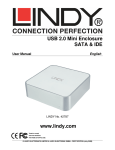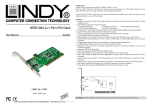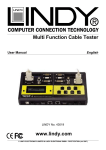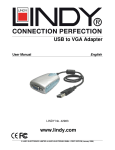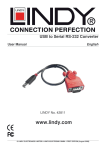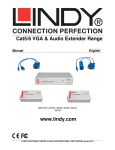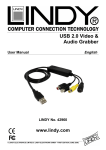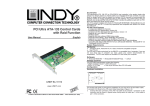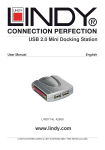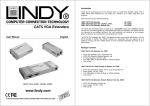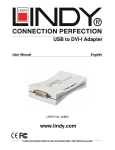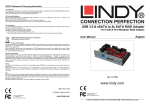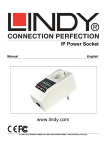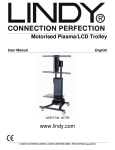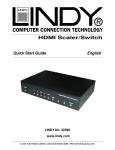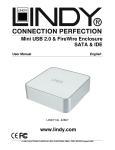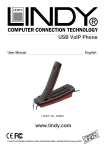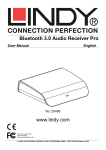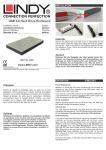Download USB 2.0 AutoSwitch PRO User Manual English
Transcript
USB 2.0 AutoSwitch PRO English User Manual LINDY No. 42843 www.lindy.com © LINDY ELECTRONICS LIMITED & LINDY-ELEKTRONIK GMBH - FIRST EDITION (October 2008) User Manual English Introduction Thank you for purchasing the LINDY USB 2.0 AutoSwitch PRO! The USB AutoSwitch PRO allows you to share a USB device between multiple computers. The USB AutoSwitch is the perfect way of sharing a printer, scanner or external storage between computers without the need for networking, perfect for home users and SOHO alike. Package Contents • • • LINDY USB 2.0 AutoSwitch PRO CD-ROM This manual Features • Allows multiple computers to share a USB peripheral including printers, scanners and external storage • Switch access between computers via auto mode, hot key or push button • Provides First Come First Served print server functionality for Windows PCs • Supports High Speed USB 2.0 devices, backwards compatible with USB 1.1 • Can be connected to a USB hub to share multiple USB devices between computers • Powered from your computer's USB port, can be used with an external power supply (sold separately) when used with higher power consumption peripherals • Compatible with Windows ME/2000/XP/Vista, Mac and Linux (Mac and Linux only support manual switching) 2 User Manual English Installation Please follow the instructions below on how to install the USB 2.0 AutoSwitch PRO for each of your computers Windows PC The following steps will allow you to install the software required to use the auto-switching functionality. If you only want to use the AutoSwitch as a manual USB switch, please skip to point 6. 1. Insert the supplied CD into your computers CD-ROM drive 2. An Autorun screen will pop up on your computers screen 3. Click Next. If you want to install the software in the default location displayed click Next again. Alternatively click Change... to choose a new directory, then click Ok, followed by Next to continue. 4. Click Install to begin the installation 5. When the installation has completed click Finish. 6. Now connect the AutoSwitch to the first computer using a USB A to B cable. 7. The computer will then automatically complete a short installation. 3 User Manual English 8. When you see the following message (or similar depending on which version of Windows you are using) the installation has completed and you may proceed to install the next computer. 9. Repeat steps 6, 7 and 8 for each computer you want to connect. Mac OS & Linux The AutoSwitch can only be used in manual mode with USB enabled versions of Mac OS and Linux so no software installation is required. Simply connect the AutoSwitch to each computer using a USB A to B cable and allow the computer to recognise and install the hardware. Repeat this for each computer which you want to connect. Operation Connect a USB device to the USB port on the front of the AutoSwitch, the example below shows a printer connected to the AutoSwitch. After installing the software (as outlined earlier) an icon will have been added to your system tray. This icon shows you the status of the AutoSwitch and also allows you to set the idle time between switches. Available (AutoSwitch is idle, no jobs pending) Occupied by you (you are already in control of the AutoSwitch!) Occupied (AutoSwitch is in use by another computer) 4 User Manual English Configuration To configure the AutoSwitch, right click on the icon in the system tray and select Config. The following menu will be displayed: Idle Time The idle time is the timeout (in seconds) that the AutoSwitch will wait after a task is finished and before the switch becomes available again. After you have entered a value (min 0, max 255), click Apply to save it and OK close the configuration tool. This needs to be repeated on each connected computer. Printer The Printer function is used to control printing from any printers which are connected to the AutoSwitch, so that jobs may be sent from any computer connected to the switch regardless of whether the printer is currently busy or not . Click Select and a list of all the printers associated with your computer will be listed (only a printer connected to the AutoSwitch can be managed) Highlight the printer to be used and click OK. This needs to be repeated on each connected computer. 5 User Manual English Switching By default the AutoSwitch will be in Auto Mode when it is connected, as indicated by the illuminated AUTO LED on the front of the AutoSwitch. To switch from Auto Mode to Manual Mode, simply press the Switch button once. Auto Mode When the switch is in Auto Mode print jobs can be sent to a connected printer regardless of whether the AutoSwitch or printer is busy. As soon as the current print job finishes and the idle time expires the next print job will commence automatically. Switching between the computers in Auto Mode is easy you can either double click on the AutoSwitch icon in the system tray or press Scroll Lock twice in quick succession on your keyboard to take control of the AutoSwitch. If the AutoSwitch icon is Red then the AutoSwitch is busy and cannot be switched Manual Mode When the switch is in Manual Mode it can be used with computers running Windows, Mac OS and Linux, though there is no control directly from the computer and no queuing of print jobs. Switching is performed by pressing the Switch button on the front of the AutoSwitch, the LEDs on the front of the AutoSwitch will denote which computer has control. Each press will move control to the next computer, until finally the AutoSwitch enters Auto Mode, as shown in the diagram below. Auto Mode (Default) Computer 4 Computer 3 Manual Mode Computer 2 Computer 1 6 Radio Frequency Energy, Certifications CE Certification This equipment complies with the requirements relating to electromagnetic compatibility, EN 55024 and EN55022 class A for ITE, EN61000-3-2/-3 the essential protection requirement of Council Directive 89/336/EEC on the approximation of the laws of the Member States relating to electromagnetic compatibility. Shielded cables must be used with this equipment to maintain compliance with radio frequency energy emission regulations and ensure a suitably high level of immunity to electromagnetic disturbances. FCC Warning This equipment has been tested and found to comply with the limits for a Class B digital device, pursuant to part 15 of the FCC Rules. These limits are designed to provide reasonable protection against harmful interference in a residential installation. This equipment generates, uses, and can radiate radio frequency energy and, if not installed and used in accordance with the instructions, may cause harmful interference to radio communications. However, there is no guarantee that interference will not occur in a particular installation. If this equipment does cause harmful interference to radio or television reception, which can be determined by turning the equipment off and on, the user is encouraged to try to correct the interference by one or more of the following measures: Reorient or relocate the receiving antenna Increase the separation between the equipment and receiver Connect the equipment into an outlet on a circuit different from that to which the receiver is connected Consult the dealer or an experienced technician for help You are cautioned that changes or modification not expressly approved by the party responsible for compliance could void your authority to operate the equipment. This device complies with part 15 of the FCC Rules. Operation is subject to the following two conditions: 1. This device may not cause harmful interference, and 2. This device must accept any interference received, including interference that may cause undesired operation. Recycling Information WEEE (Waste of Electrical and Electronic Equipment), Recycling of Electronic Products United Kingdom In 2006 the European Union introduced regulations (WEEE) for the collection and recycling of all waste electrical and electronic equipment. It is no longer allowable to simply throw away electrical and electronic equipment. Instead, these products must enter the recycling process. Each individual EU member state has implemented the WEEE regulations into national law in slightly different ways. Please follow your national law when you want to dispose of any electrical or electronic products. More details can be obtained from your national WEEE recycling agency. Germany / Deutschland Die Europäische Union hat mit der WEEE Direktive umfassende Regelungen für die Verschrottung und das Recycling von Elektro- und Elektronikprodukten geschaffen. Diese wurden von der Bundesregierung im Elektro- und Elektronikgerätegesetz – ElektroG in deutsches Recht umgesetzt. Dieses Gesetz verbietet vom 24.März 2006 an das Entsorgen von entsprechenden, auch alten, Elektro- und Elektronikgeräten über die Hausmülltonne! Diese Geräte müssen den lokalen Sammelsystemen bzw. örtlichen Sammelstellen zugeführt werden! Dort werden sie kostenlos entgegen genommen. Die Kosten für den weiteren Recyclingprozess übernimmt die Gesamtheit der Gerätehersteller. France En 2006, l'union Européenne a introduit la nouvelle réglementation (DEEE) pour le recyclage de tout équipement électrique et électronique. Chaque Etat membre de l’ Union Européenne a mis en application la nouvelle réglementation DEEE de manières légèrement différentes. Veuillez suivre le décret d’application correspondant à l’élimination des déchets électriques ou électroniques de votre pays. Italy Nel 2006 l’unione europea ha introdotto regolamentazioni (WEEE) per la raccolta e il riciclo di apparecchi elettrici ed elettronici. Non è più consentito semplicemente gettare queste apparecchiature, devono essere riciclate. Ogni stato membro dell’ EU ha tramutato le direttive WEEE in leggi statali in varie misure. Fare riferimento alle leggi del proprio Stato quando si dispone di un apparecchio elettrico o elettronico. Per ulteriori dettagli fare riferimento alla direttiva WEEE sul riciclaggio del proprio Stato. LINDY No. 42843 1st Edition, October 2008 www.lindy.com








